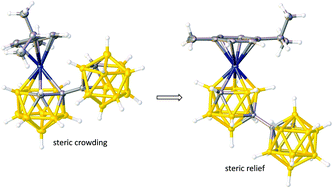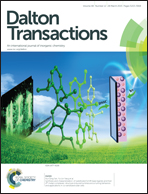Abstract
Examples of singly-metallated derivatives of 1,1′-bis(o-carborane) have been prepared and spectroscopically and structurally characterised. Metallation of [7-(1′-1′,2′-closo-C2B10H11)-7,8-nido-C2B9H10]2− with a {Ru(p-cymene)}2+ fragment affords both the unisomerised species [1-(1′-1′,2′-closo-C2B10H11)-3-(p-cymene)-3,1,2-closo-RuC2B9H10] (2) and the isomerised [8-(1′-1′,2′-closo-C2B10H11)-2-(p-cymene)-2,1,8-closo-RuC2B9H10] (3), and 2 is easily transformed into 3 with mild heating. Metallation with a preformed {CoCp}2+ fragment also affords a 3,1,2-MC2B9-1′,2′-C2B10 product [1-(1′-1′,2′-closo-C2B10H11)-3-Cp-3,1,2-closo-CoC2B9H10] (4), but if CoCl2/NaCp is used followed by oxidation the result is the 2,1,8-CoC2B9-1′,2′-C2B10 species [8-(1′-1′,2′-closo-C2B10H11)-2-Cp-2,1,8-closo-CoC2B9H10] (5). Compound 4 does not convert into 5 in refluxing toluene, but does do so if it is reduced and then reoxidised, perhaps highlighting the importance of the basicity of the metal fragment in the isomerisation of metallacarboranes. A computational study of 1,1′-bis(o-carborane) is in excellent agreement with a recently-determined precise crystallographic study and establishes that the {1′,2′-closo-C2B10H11} fragment is electron-withdrawing compared to H.

- This article is part of the themed collection: In memory of Professor Kenneth Wade


 Please wait while we load your content...
Please wait while we load your content...